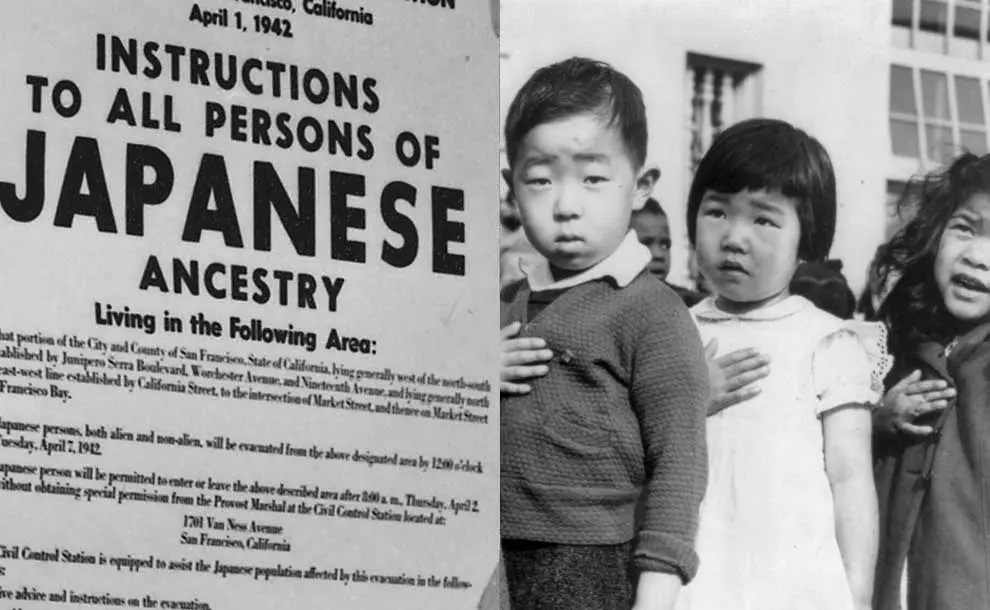
This 1945 photo shows Shizuko Ina, with her son Kiyoshi (left) and daughter Satsuki in an internment camp in Tule Lake (California). This photograph was taken by a family friend who was a soldier at the time, since cameras were considered contraband at the camp. Satsuki was born at the camp.
Courtesy of the Ina family/AP
BY: REECE PASCOE
Fear can come from lack of knowledge, and in the hands of power, fear can do damage.
After Pearl Harbor, December 7, 1941, the U.S. Department of War designated the West Coast as a theater of operations. America was now officially fighting a two-front war.
Six months prior to Pearl Harbor, Lieutenant General John L. Dewitt had been put in command of California, Oregon, and Washington.
But, on February 19, 1942, President FDR signed an executive order: Order 9066. This gave the Commander Dewitt all power. And when I say all power, I do mean that.
The order gave Dewitt power to relocate anyone deemed a threat to national security: the Japanese.
At first Dewitt made the relocation optional. Then a couple of days later it became mandatory, and failure would result in arrest and fines.
In addition to relocation, most property owned by the Japanese was seized, and included boats, property, cars and businesses.
The Japanese were relocated to internment camps, which varied widely.
Some camps were more like little towns including schools for the children, baseball leagues, and normal day activities. Others were more like Guantanamo Bay, more prison like.

Minidoka (Idaho) had 36 residential blocks. Each block had 12 barracks, a mess hall, and a latrine. Each barrack was 120’x 20’, which was then divided into six units. Each unit would house a family or a group of individuals. Each unit had a single lightbulb and a coal burning stove. The walls dividing the units did not extend to the ceiling and the barracks had no insulation.
The variation of the camps was due to the way the order was written: it gave power to the commanders in charge. Some commanders were generous with food, clothes, housing, and activities. While other took inspiration from the Germans and treated those in camps like cattle.
A Japanese person was defined as anyone who was at least 1/16th Japanese.
Close to 120,000 Japanese were relocated or affected in some way or another. More than 17,000 were children under the age of 10.
Most forced into camps were Americans citizens, many going back generations of being proud to be an American.
Internment camps were found throughout the U.S., from California to Arkansas.
Relocation centers were the main hubs for the incoming detainees. The Japanese would get processed at a center at Tule lake (California), Topaz (Utah), Jerome ( Arkansas), Heart Mountain (Wyoming), Poston (Arizona), Granda (Colorado) or Rohwer (Arkansas).
Once processed some got to stay at the camps at the relocation centers, while others were less fortunate.

Workers sort the baggage of Japanese Americans after arrival at the Relocation Center in Idaho.
Photo: the Bancroft Library. University of California, Berkeley
Those unlucky ones could be shipped across the country to an isolation center, assembly center, or temporary camp.
All of these terms for internment camps is just sugar coating it. Each camp was terrible in its own right, some were labor camps, some were jails. If you were a military-aged male, it was more likely that you got sent to a labor camp.
Once FDR signed this order, like all things America leads the way. Mexico followed suit, then most of the South American countries deported the Japanese from their country and shipped them to America to be locked up.
Outrage followed FDR’s order.
The three loudest voices were Gordon Hirabayashi, Fred Korematsu and Mitsuye Endo. These three Americans filed lawsuits against the government citing civil liberties.
Only Mitsuye Endo was successful in her lawsuit as she was allowed to leave the internment camp in Topaz, because the justices ruled unanimously that the war relocation authority (power given under the Executive Order 9066) “was without authority, express or implied, to subject to its leave procedure a concededly loyal and law-abiding citizen of the United States.”
Gordon Hirabayashi lost his legal battle in the courts. Hirabayashi was convicted on two counts and the one that he lost his court battle was on curfew. This curfew specified that all Japanese had to be in their residences between the hours of 8 p.m. and 6 a.m. The Ninth Circuit decided that “the curfew order did not unconstitutionally discriminate against citizens of Japanese ancestry.”
Fred Korematsu, an American was born in Oakland in 1919. When he was growing up he faced discrimination, and it got so bad that Korematsu even tried to go by the name Clyde Sarah.
He was arrested when he refused to go to the internment camps. The ACLU got wind of it and reached out to Korematsu and helped bring the case to the federal court. Korematsu lost and was sentenced to five years’ probation in the Topaz (Utah) Internment Camp.
Then 30 years later he was justified, when he was awarded the Medal of Freedom by President Bill Clinton. He died in 2005.
The last camp was closed in March of 1946, and in 1976 President Gerald Ford officially repealed FDR’s Executive Order 9066.
In 1988 President Ronald Reagan and Congress passed the Civil Liberties Act which gave $20,000 for every person who was incarcerated in internment camps.
Legislation establishing Fred Korematsu Day was first signed into law by New York City in 2008 and in September 2010 it was signed into law by then Governor Arnold Schwarzenegger, after it was passed unanimously in the Assembly and Senate.
Fun fact: Fun fact: After World War II, the Japanese Cherry Tree was almost wiped out of that country because of American bombing. The U.S. shipped cuttings from Washington D.C.’s cherry trees back to Japan to help reforest the species.





Please inquire about the Internment Presentation developed and presented by the late Ted Tanaka of the Palisade Highlands. His Sons Scott and Ryan would probably have access to it! It’s an extremely accurate and informative presentation of this period of time in the Camps!